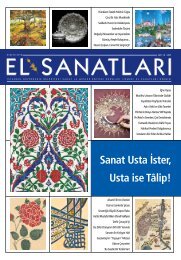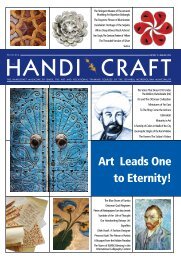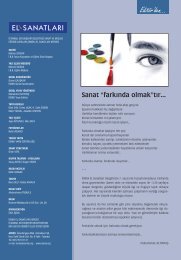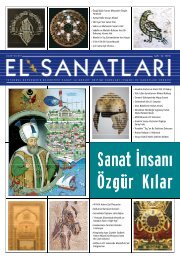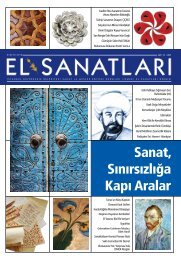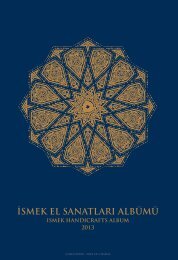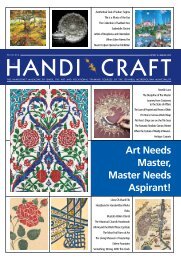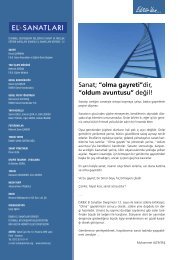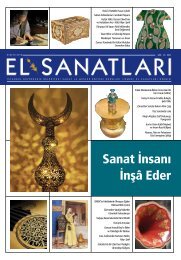Download Link - Ä°SMEK
Download Link - Ä°SMEK
Download Link - Ä°SMEK
Create successful ePaper yourself
Turn your PDF publications into a flip-book with our unique Google optimized e-Paper software.
to an end. Year 1308 was not only the date of Masud<br />
the 2nd's death but it is also taken as the year when<br />
the Anatolian Seljuk State collapsed by the historians. 12<br />
Throughout two centuries of existence the Anatolian<br />
Seljuk State managed to produce very significant<br />
works of art in spite of all these disorders. The studies<br />
on Seljuk Arts have been miscellaneous. One of<br />
those is the studies on ornaments. In the Anatolian<br />
Seljuk structures, it is noticed that the architectural<br />
elements were decorated with different materials.<br />
There are decorating elements that can be divided<br />
into four main groups as geometrical, figured, calligraphy<br />
(script) and floral in the patterns on stone, wood,<br />
ceramics and even stucco as decoration material, although<br />
the last one doesn't have many examples.<br />
Besides intermingled arrangements were sometimes<br />
processed together, one of these ornament forms is<br />
seen in the foreground in the patterns. In ornaments<br />
that calligraphy and floral patterns were used together<br />
calligraphy comes to the foreground, or that geometrical<br />
and floral ones were used together geometrical ornament<br />
is seen in the foreground. Here, we are going<br />
to study the usage of the rumi pattern in arrangement<br />
of portal ornament of the structures in the Anatolian<br />
Seljuk architecture in chronological order. Although<br />
it was used in the Middle East before Anatolia, this<br />
pattern took the name “Rumi”, a name dedicated to<br />
Anatolia, because of the intense usage in the Anatolian<br />
Seljuk period.<br />
Detail from the portal of Hatuniye Madrasa in Karaman<br />
In the Southeastern Anatolian region where we found<br />
the earliest examples of mosque architecture, influence<br />
of Syria is seen. The very first examples were built<br />
before the Anatolian Seljuk period and were revised<br />
in the period of Malik-Shah. One of these is the Great<br />
Mosque of Diyarbakir (Ulu Mosque) (1092) 13 and its<br />
plan proves the situation as it replicates the Umayyad<br />
Mosque in Damascus. With the ancient capitalled columns<br />
on the two-storey cloisters by the yard, the patterns<br />
on the spiral branches on the stringcourse taking<br />
place on the elevation and its cove moldings it reflects<br />
the eclectic features of the period.<br />
In 1086 Silvan was taken under the control of the<br />
Great Seljuk State and given to the Artuqids as fief.<br />
Silvan Ulu Mosque (1224) 14 is important because its<br />
blind gallery in the north elevation and the corbel remnants<br />
which supposed to bear a cornice showed a different<br />
elevation arrangement. These rows of corbels<br />
and the surfaces of their rosettes are decorated with



